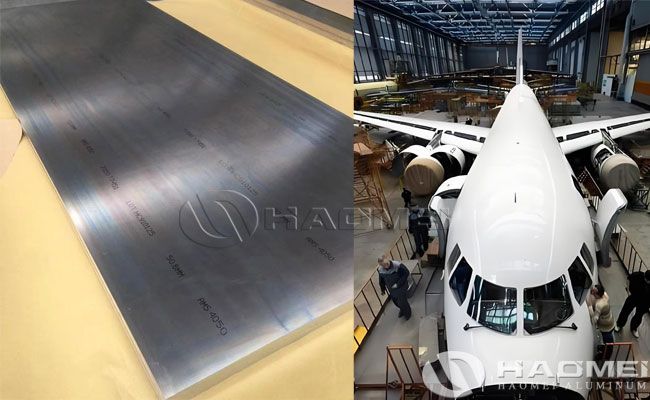
![]() Home > News
Home > News
Source:https://www.aircraft-aluminium.com/a/aluminum-7050-t7451-for-aerospace-fuselage-frames-and-wing-skins.html
7050 T7451 aluminum alloy is a high-strength aluminum alloy belonging to the 7000 series, it is widely used in the aerospace industry. In aerospace design, aluminum 7050 T7451 is often used to manufacture critical structural components such as fuselage frames, wing skins and landing gear to ensure aircraft safety and reliability during flight.

The Role of Chemical Composition
- Zinc (Zn): A content of 5.7%-6.7% is one of the primary strengthening elements. It synergizes with elements such as magnesium and copper to form a strengthening phase, significantly enhancing the alloy's strength.
- Magnesium (Mg): A content of 1.9%-2.6% forms a MgZn₂ strengthening phase with zinc, increasing the alloy's strength and hardness while also improving its toughness and corrosion resistance.
- Copper (Cu): A content of 2.0%-2.6% further strengthens the alloy, increasing its strength, hardness, and heat resistance, while also improving its processing properties.
- Zirconium (Zr): 0.08%-0.15% zirconium replaces chromium, reducing the alloy's quenching sensitivity, improving its strength and stress corrosion resistance, and also refining the grain size, improving the alloy's overall performance.
- Other trace elements: Low levels of impurities such as silicon (Si) and iron (Fe) help ensure the alloy's purity and performance stability. Titanium (Ti) refines the grain size, improving the alloy's strength and toughness.
Heat-Treated Tempering
The T7451 temper of 7050 aluminum is achieved through solution treatment (475°C) followed by artificial aging (120-175°C). This treatment optimizes the material's stress corrosion resistance and fracture toughness.
Mechanical Properties
- Strength: Tensile strength reaches 470 MPa, yield strength is 390 MPa, elongation is 6%, and hardness is approximately 150 HBW. Its high strength far exceeds that of mild steel, enabling it to withstand the high stresses required of aerospace structural components.
- Other characteristics: Density is approximately 2.9 g/cm³, coefficient of thermal expansion (20-100°C) is 23.5 μm/m·K, melting point range is 490-630°C, electrical conductivity is 41% IACS at 20°C, elastic modulus is 71.0 GPa in tension, 26.9 GPa in shear, and 72.4 GPa in compression.
Comparison with Other Aluminum Alloys
Compared to the common 7075 aluminum alloy, 7050-T7451 has higher zinc and copper content and replaces chromium (Cr) with zirconium (Zr). This gives 7050-T7451 superior strength and stress corrosion resistance, but it is slightly more difficult to process and relatively more expensive. In terms of mechanical properties, 7050-T7451 generally has higher tensile strength and yield strength than 7075 aluminum, and better fatigue resistance, making it more suitable for critical aerospace structural parts requiring extremely high strength and corrosion resistance.
Processing Key Points
- Hot Working:
7050-T7451 can be formed through hot working processes such as extrusion, forging, and die forging. During hot working, the heating temperature and processing speed must be carefully controlled. Generally, the hot working temperature is around 400-450°C to ensure good plasticity and formability while avoiding defects such as overheating and overburning.
- Cold Working:
After solution treatment, the material exhibits good plasticity and can be cold worked, such as rolling, stretching, and bending, to obtain the desired shape and size. However, cold working can cause work hardening, requiring appropriate annealing to restore the material's plasticity and toughness.
- Surface Treatment:
To further enhance the corrosion and wear resistance of 7050-T7451, surface treatments such as anodizing, electroless nickel plating, and painting are possible. Anodizing forms a hard, wear-resistant, and corrosion-resistant oxide film on the surface, effectively extending the material's service life.
Performance Advantages
- High Strength and Lightweight:
Its strength approaches that of mild steel, yet its density is only one-third that of steel. While maintaining the strength of fuselage frames and wing skins, it effectively reduces aircraft weight, improving fuel efficiency and flight performance.
- Corrosion Resistance:
It exhibits excellent resistance to stress corrosion cracking and exfoliation corrosion, adapting to the complex environmental conditions of aerospace, such as low temperatures, humidity, and atmospheric corrosives at high altitudes, extending the service life of structural components.
- Processability:
It can be formed through processes such as extrusion, forging, and die forging, making it suitable for manufacturing complex shapes of fuselage frames and wing skins, meeting the stringent precision and shape requirements of the aerospace industry.
In addition to aerospace applications for fuselage frames and wing skins, aluminum 7050 t7451 is also widely used in high-stress structural components such as aircraft spars, stringers, and landing gear, as well as in mold processing, machinery frames, military equipment, and racing car parts, where high strength and corrosion resistance are required.
Boeing 787: 7050-T7451 is used in the manufacture of the Boeing 787's wing skins and fuselage frame structures. Its high strength and lightweight properties help reduce the aircraft's overall weight and improve fuel efficiency. Its excellent corrosion resistance also ensures structural safety and reliability during long-term flight.
Airbus A350: In the manufacture of the Airbus A350, 7050-T7451 is also widely used in critical components such as wing spars and stringers. These components are subject to significant stress, and 7050-T7451's high strength and excellent fatigue resistance meet these requirements.